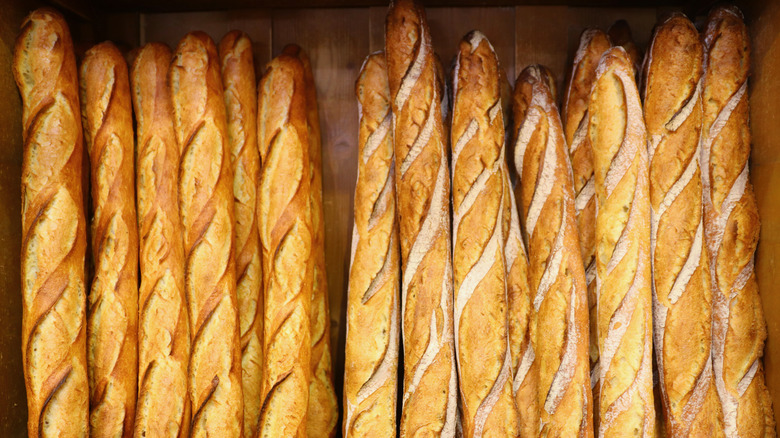The French Baguette Is Now Under Cultural Protection By The U.N.
When you think of French cuisine, you may think of rich buttery sauces, posh pastries, and elegant meals. Or perhaps you think of a warm, freshly baked baguette. There's just something about biting into the delightfully crisp crust to get to that soft fluffy center. And now, the art of making a quality baguette has attained special status alongside other globally recognized cultural arts and traditions.
On Wednesday, November 30, CNN reported that the United Nations Educational, Scientific and Cultural Organization (UNESCO) officially recognized the baguette as part of the world's "intangible cultural heritage." This category refers to valued oral histories, performing arts, and skilled cultural crafts instead of more tangible monuments and objects.
An authentic baguette contains just flour, water, salt, and leaven or yeast. Even though the ingredients are simple, UNESCO argues that the baker is an artisan with specific skills and expertise, as so many variables may change the outcome. Making baguettes traditionally requires an elaborate process of weighing and mixing ingredients, kneading, twice fermenting, shaping, and scoring the dough before baking them in small batches.
The role of the baguette in French culture is part of the social fabric, according to UNESCO's director general Audrey Azoulay. She described the ritual of buying a fresh baguette as "a way of life." "There is always a boulangerie nearby, you can go and buy fresh affordable bread and you meet people, meet with bakers," she told CNN.
Baguette's transition from practical to icon
The baguette-making tradition runs so deep that there are even laws protecting the craft. NPR reported that the original baguette was created by Vienna-born baker August Zang who innovated the use of a special steam oven in 1839. French bakers perfected it during the 1920s after a law passed forbidding bakers from beginning work any earlier than 4 a.m. Under these circumstances, the "long, thin" baguette "was the only bread that bakers could make in time for breakfast."
This isn't the only French law that shaped the baguette. In 1993 the "Décret Pain" clarified what could be considered a traditional baguette. It states that the bread must be sold at the boulangerie where it was baked, can't be frozen (which means it'll get stale after about a day), and must only contain four ingredients. You'll know you're at a true boulangerie when you see a small yellow and blue sign containing the words "Votre boulanger. Un artisan authentique," according to BBC's Good Food.
You may have noticed a delicious baguette can dry out, harden and go stale faster than some other types of bread because of the simple ingredients. While a baguette is best fresh, there are plenty of ways to use stale baguettes, including bread pudding and, appropriately, French toast.

